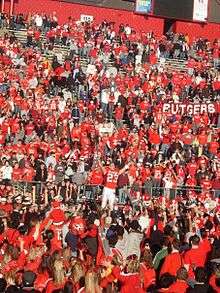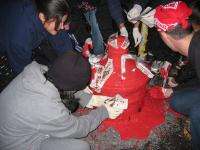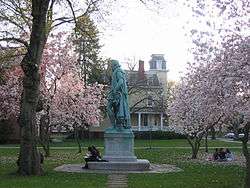Rutgers University traditions and customs
As one of the first nine colleges founded in the United States of America—founded as Queen's College in 1766 (a decade before the country's independence from Great Britain)—Rutgers, The State University of New Jersey has two-and-a-half centuries of tradition and heritage.
School spirit

Colors, mottos and mascots
Rutgers University's only school color is scarlet. Initially, students sought to make orange the school color, citing Rutgers' Dutch heritage and in reference to the Prince of Orange. The Rutgers student publication "Targum" (which would go on to become the Daily Targum) first proposed that scarlet be adopted in May 1869, claiming that it was a striking color and because scarlet ribbon was easily obtained. During the first intercollegiate football game with Princeton on 6 November 1869, the players from Rutgers wore scarlet-colored turbans and handkerchiefs to distinguish them as a team from the Princeton players.[1] The Board of Trustees officially made scarlet the school color in 1900.[1]
In its early days, Rutgers athletes were known informally as "The Scarlet" in reference to the school color, or as "Queensmen" in reference to the institution's first name, Queen's College.[1] In 1925, the mascot was changed to Chanticleer, a fighting rooster from the medieval fable Reynard the Fox (Le Roman de Renart) which was used by Geoffrey Chaucer's in the Canterbury Tales.[1] At the time, the student humour magazine at Rutgers was called Chanticleer, and one of its early arts editors, Ozzie Nelson (later of The Adventures of Ozzie and Harriet fame) was quarterback of the Rutgers team from 1924 to 1926.[2] The Chanticleer mascot was unveiled at a football game against Lafayette College, in which Lafayette was also introducing a new mascot, a leopard.[2] However, the choice of Chanticleer as a mascot was often the subject of ridicule because of its association with "being chicken."[3] In 1955, the mascot was changed to the Scarlet Knight after a campus-wide election, beating out other contenders such as "Queensmen", the "Scarlet", the "Red Lions", the "Redmen" and the "Flying Dutchmen."[1][4] Earlier proposed nicknames included "Pioneers" and "Cannoneers". When Harvey Harman, then coach of the football team, was asked why he supported changing the Rutgers mascot, he was quoted as saying, "You can call it the Chanticleer, you can call it a fighting cock, you can call it any damn thing you want, but everybody knows it's a chicken."[5] Harman later is said to have bought the first "Scarlet Knight" mascot costume for the 1955 season, which was to be his final season as football coach at Rutgers.[6]
Rutgers' motto, Sol iustitiae et occidentem illustra (translated as "Sun of righteousness, shine upon the West also") is derived from the motto of the University of Utrecht in The Netherlands, which is Sol Iustitiae Illustra Nos (translated as "Sun of Justice, shine upon us"). It is a reference to the biblical texts of Malachi 4:2 and Matthew 13:43.[7] This motto appears in the University's seal (pictured above), which is also derived from that of the University of Utrecht, and depicts a multi-pointed sun.[8]
Coat of Arms
The shield of the Rutgers coat of arms appears on the university gonfalon, and is at the head of all processions. The first quarter bears the arms of Nassau, the House of Orange, and recognizes the Dutch founders. The arms in the upper sinister quarter are those of George III combined with Queen Charlotte’s. It was George III who granted the Charter of 1766 to Queen’s College, named in honor of Charlotte of Mecklenburg, King George’s consort. The arms shown on the sinister half are Queen Charlotte’s. The third quarter from the Seal of the State of New Jersey. The fourth quarter is the coat of arms of Colonel Henry Rutgers.

Seal
The University Seal based on that of the University of Utrecht in the Netherlands whose motto around a sun is “ Sol iustitiae nos illustra”:“Sun of righteousness, shine upon us”. Rutgers modified the Utrecht seal to read “Sol iustitiae et occidentem illustra”; embracing the Western world, meaning “Sun of righteousness, shine upon the West also.” The boards of governors and trustees approved a revised seal for the University 1997 that includes the words “Rutgers, The State University of New Jersey” and adds the 1766 founding date.
School songs and chants
Several school songs are connected with the school's athletic heritage. The alma mater of Rutgers University is On the Banks of the Old Raritan with words written by Howard Fullerton (Rutgers Class of 1874) and adapted to an old Scottish melody On the Banks of the Old Dundee.[9][10] It is typically performed at the close of athletic events by the university's marching band, the Marching Scarlet Knights (also called "The Pride of New Jersey"), at Rutgers University Glee Club concerts, commencement and other important school events. The university's fight song, The Bells Must Ring, is performed often during athletic events especially in recognition of notable scores. Written in 1931 for entry in a student song contest, pianist Richard M. Hadden (Rutgers Class of 1932) composed the song with W. E. Sanford (Rutgers Class of 1930). Between the verses of the fight song, the spirit chant is rhythmically shouted.[11]
- R-U Rah Rah!
- R-U Rah Rah!
- Hoo-Rah! Hoo-Rah!
- Rutgers, Rah!
- Upstream, Red Team!
- Red Team; upstream!
- (Men) Rah! (Women) Woo! (Men) Rah! (Women) Woo! (All) Rutgers, Rah![11][12]
This chant is one of many recited during Rutgers athletic events. Another popular chant—a "call-and-response" in which one side of the stadium crowd calls out "R" and the other side of the stadium responds with "U" antiphonally, (shorthanded for "Rutgers University") is often performed. Though has not been performed in the modern era, the original spirit chant used at Rutgers was "Rah! Rah! Rah! Bow-wow-wow! Rutgers!"[13][14]
In a songbook and in sheet music published by Shapiro, Bernstein & Co. in 1936, the song Loyal Sons of Rutgers was found. The music was attributed to Philip Bliss, and the lyrics in the sheet music were added by Ozzie Nelson (Rutgers Class of '27.) Nelson used it as an early theme song for his radio show. The lyrics as published in the songbook may or may not be the ones Nelson added. They are:
- Loyal sons of Rutgers, battling
- 'Mid the shadows of the twilight,
- For the prestige of old Rutgers,
- On the gridiron now they fight.
Chorus:
- Ring the bells of old Queen's College,
- Paint the town as ne'er before!
- Play the game, boys, play together!
- Score once more, oh, score once more.
Second Verse:
- Hit the lines and run the ends boys,
- Play the game with heart and soul.
- Right on through, at ev'ry plunge, boys,
- Push the ball across the goal
- (repeat chorus)
Other notable songs include Nobody ever died for Dear Old Rutgers composed by Jule Styne to lyrics by Sammy Cahn from the 1947 musical High Button Shoes parodies an 1892 game in which Frank "Pop" Grant, a Rutgers football player, was being taken from the field because of injuries and stated that he would "die for dear old Rutgers." Other's sources state that the player stated "I will die if somebody does not give me a cigarette."[15] The song Loyal Sons which exhorts Rutgers athletes (particularly football players) to "hit the line and run the ends boys...Score once more. Oh score once more."
Athletic rivalry
Rutgers maintains athletic rivalries with other collegiate institutions. The university has a historic rivalry with Princeton University and Columbia University (formerly King's College) originating from the early days of college football. While they maintain this rivalry in other sports, the football rivalry series with Princeton was discontinued after the 1980 series "at the request of Princeton officials, who felt that Rutgers’ step toward big‐time football in recent seasons had taken the Scarlet Knights out of the Tigers’ desired class of competition."[16] Rutgers has a Basketball rivalry with Seton Hall University.
College pranks
Rutgers-Princeton Cannon War

Howard Fullerton goes down in Rutgers history not only for penning the alma mater, but also for allegedly inspiring the theft of a cannon from the campus of Princeton University on April 25, 1875, an event—and the ensuing debate between the two university presidents—reported sensationally in nationwide newspapers. The cannon was believed to have belonged to Rutgers when used in battle during the American Revolution. Under the cover of night, a dozen Rutgers students, stole the cannon from its place at Princeton, and brought it back by wagon to New Brunswick before the following dawn. In retaliation, Princeton students raided the Rutgers Armory and stole a few muskets. Reputedly—though this may have been baseless rhetoric originating from the heated debate after the theft—the Rutgers students are accused of having stolen the wrong cannon. Eventually the committee appointed by the two colleges recommended the return of the stolen items to their owners.[17][18] When the cannon was returned, Princeton University officials ordered it buried in the ground, encased in cement, with only a few feet of the butt end exposed above ground.[19]
Several Rutgers students attempted to repeat the crime, unsuccessfully, in October 1946, attaching one end of a length of heavy chain to the cannon and the other to their Ford. Surprised by Princeton men and the local constabulary, they gunned the engine of the Ford so viciously that the car was torn in half. The Rutgers army managed to escape, but with neither the car nor the cannon.[14]
To this day, intrepid Rutgers students journey the 16 miles to Princeton University to place their declaration of ownership of the cannon by painting the cannon scarlet red. There are two cannons on Cannon Green behind Nassau Hall at Princeton.[14][17][18] Today, a cannon is placed in the ground before Old Queens at Rutgers, by the class of 1877, memorializing both this event and several alumni in the armed services who were killed in action.
Around Campus
Statue of William the Silent

Fenton B. Turck, a New York physician and biologist, with the assistance of railroad magnate, and longtime Rutgers trustee Leonor F. Loree (RC 1877), anonymously donated a statue of William of Orange (William I, Prince of Orange, 1533–1584) commonly known as William the Silent, who was the leader of the Dutch rebellion against the Spanish that set off the Eighty Years' War and resulted in the formal independence of the United Provinces in 1648. Turck, of Dutch extraction, intended to give the statue known familiarly as " Willie the Silent" to the University to signify the institution's Dutch roots. He kept the statue in the basement of his laboratory in Manhattan for eight years before it was unveiled on the Voorhees Mall on 9 June 1928.[20] According to student tradition, the statue is said to whistle when a virgin in her senior year passes by. So far, Prince William has remained silent.[21][22]
This statue is a rough replica of a similar monument that stands in The Hague.
Passion Puddle
Passion Puddle is a small, tree-shaded pond on Douglass campus. According to legend, if one circles the pond three times with their romantic interest, they will be married within a year. Traditionally, if a Douglass College girl and a Cook College boy circle it three times, they are meant to live happily ever after.[23]
Commencement
At Commencement exercises in the spring, tradition leads undergraduates to break clay pipes over the Class of 1877 Cannon monument in front of Old Queens, symbolizing the breaking of ties with the college, and leaving behind the good times of one's undergraduate years. This symbolic gesture dates back to when pipe-smoking was fashionable among undergraduates, and many college memories were of evenings of pipe smoking and revelry with friends.
During commencement exercises, graduating seniors walk in academic procession under the Class of 1902 Memorial Gateway (erected in 1904) on Hamilton Street leading to the Voorhees Mall where the ceremonies were held for Rutgers College. Traditionally, students are warned to avoid walking beneath the gate before commencement over a superstition that one who does will not graduate in four years.
Recent customs and annual events
For thirty years, through 2011, there was an annual concert called Rutgersfest, typically held on Busch or Livingston campus. The concert had novelties and stands nearby, and people from outside the campus came to crowd in and dance near the band. The concert met its demise when students and others got rowdy in New Brunswick after the 2011 Rutgersfest.[24]
Since 2003, there has been an annual campout/protest called Tent State University.[25][26] This is held on Voorhees Mall, and began in 2003 in response to proposed education budget cuts and tuition increases. While other colleges and campuses hold Tent State campouts/protests, the movement began at Rutgers.
The newest annual event, Rutgers Day, has been held since 2009. While some might consider it too new to be a tradition, the event has been quite popular, with some 50,000 people estimated to have shown up to the first one.[27] During a Rutgers Day festival, the departments and schools of Rutgers put on exhibits and displays for the general public, producing what is, in effect, an enormous one-day carnival. Rutgers Day now contains the New Jersey Folk Festival within it, which is an older annual event that happens on Douglass Campus, and which has been going on since the mid-1970s.[28]
The Grease Trucks have been called a Rutgers institution,[29] and so eating at those trucks can be said to be a Rutgers tradition. Those trucks served sandwiches with various names, such as Fat Cat, Fat Sam, and Fat Darrell. The trucks previously occupied a space opposite Scott Hall on College Avenue Campus, but in 2013 were removed permanently by Rutgers DOT.[30]
See also
- Rutgers University
- Athletics at Rutgers University
- History of Rutgers University
- History of New Jersey
References
- 1 2 3 4 5 Tradition at www.scarletknights.com. Published by Rutgers University Athletic Department (no further authorship information available), accessed 10 September 2006.
- 1 2 Scarlet Letter 1924 (Rutgers University yearbook), Special Collections and University Archives, Rutgers University Libraries.
- ↑ November 1948 in Fifty Years Ago: Class of 1951 at published by the Princeton Class of 1951, edited by J. Sprigg Duvall (no further authorship information available). Accessed 12 January 2007.
- ↑ Series of articles in the spring of 1955 issues of the Rutgers Targum (then printed weekly), the Rutgers University campus newspaper. Microfilm records v.94:no.36-v.104:no.58 APR 17,1953-DEC 5,1972, Archibald S. Alexander Library, Current Periodicals and Microforms Department, Rutgers University, New Brunswick, New Jersey
- ↑ Quoted in the Rutgers Targum (8 April 1955). Microfilm records v.94:no.36-v.104:no.58 APR 17,1953-DEC 5,1972 (1 roll) Archibald S. Alexander Library, Current Periodicals and Microforms Department, Rutgers University, New Brunswick, New Jersey
- ↑ Editorial in the Rutgers Targum (9 September 1955). Microfilm records v.94:no.36-v.104:no.58 APR 17,1953-DEC 5,1972, (1 roll) Archibald S. Alexander Library, Current Periodicals and Microforms Department, Rutgers University, New Brunswick, New Jersey
- ↑ King James Bible, Book of Malachi, Chapter 4 verse 2: "But unto you that fear my name shall the Sun of righteousness arise with healing in his wings; and ye shall go forth, and grow up as calves of the stall." and King James Bible, Gospel According to St. Matthew, Chapter 13, verse 43: "Then shall the righteous shine forth as the sun in the kingdom of their Father. Who hath ears to hear, let him hear."
- ↑ Presidential Inauguration: Inauguration Pageantry and Color accessed 9 September 2006.
- ↑ George J. Lukac (ed.), Aloud to Alma Mater. (New Brunswick, New Jersey: Rutgers University Press, 1966), 70-73. (No ISBN)
- ↑ "Singing Songs of Scarlet" from the Daily Targum 18 May 2006.
- 1 2 Richard M. Hadden RC'32, November 20, 1910 - July 9, 2003: Composer of "The Bells Must Ring" at Rutgers Alumni News, published by Rutgers University Office of Alumni Relations (no further authorship information available), accessed 12 January 2007.
- ↑ "The Bells Must Ring" at Traditional Rutgers Songs, published by Rutgers University (no further authorship information available), accessed 12 January 2007
- ↑ Scarlet Letter 1890 (Rutgers University yearbook), Special Collections and University Archives, Rutgers University Libraries.
- 1 2 3 Rutgers Through the Years Timeline at Rutgers University, accessed 12 August 2006.
- ↑ History and Tradition published by the Rutgers Touchdown Club (No further authorship information available). Accessed 12 January 2007
- ↑ "Princeton, Rutgers End Football Series". The New York Time. January 21, 1979. Retrieved November 25, 2016.
- 1 2 ""Princeton-Rutgers Cannon War" at Orange Key Virtual Tour". Princeton University. Archived from the original on 2006-09-02. Retrieved 2006-08-12.
- 1 2 ""Cannons, Princeton" adapted from Leitch, A Princeton Companion (Princeton, NJ: Princeton University Press, 1978).". Princeton University. Retrieved 2006-08-12.
- ↑ Some Legends & Lore of Princeton University: Historical Sketches accessed 12 August 2006.
- ↑ Paths to Historic Rutgers: A Self-Guided Tour, at Rutgers University, accessed 9 August 2006.
- ↑ Unofficial Guide to Rutgers University at fatdarrell.com quoting Chondroff, Michael. The Rutgers Students Unofficial Guide to College: A Book of Bests and Worsts of Rutgers Students' Life at College (East Brunswick, New Jersey: Arm Publishing, 1998). Accessed 24 December 2006.
- ↑ "Weird RU: Campus Legends Rise from the Dead" from The Daily Targum 31 October 2003. Accessed 24 December 2006.
- ↑ Capone, Connie. "Romantic Retreats Reside at Rutgers". The Daily Targum. Retrieved 4 March 2015.
- ↑ http://www.nj.com/news/index.ssf/2011/04/rutgers_to_cancel_annual_rutge.html
- ↑ http://www.dailytargum.com/news/th-tent-state-packs-up-earlier-than-expected/article_87620e00-8aa9-11e1-ae39-0019bb30f31a.html
- ↑ http://www.mycentraljersey.com/article/20130415/NJNEWS/304150054/In-state-tuition-undocumented-students-goal-annual-Tent-State-Rutgers
- ↑ http://news.rutgers.edu/focus/issue.2009-05-11.8490510162/article.2009-05-11.9281487153
- ↑ http://southbrunswick.patch.com/articles/nj-folk-festival-to-bring-music-to-the-masses-for-39th-year-0cad7cce
- ↑ http://www.nj.com/news/index.ssf/2012/06/get_the_truck_out_of_here_rutg.html
- ↑ Grease Trucks
External links
- Rutgers, The State University of New Jersey
- ScarletKnights.com: Official Site of Rutgers Intercollegiate Athletics